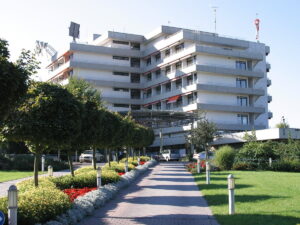Liver cirrhosis
Symptoms indicating the need for diagnosis and treatment
The main clinical manifestations of liver cirrhosis include:
- Fatigue, rapid exhaustion
- Abdominal discomfort
- Low-grade fever (37—37.5°C)
- Nausea, heartburn
- Pain in the right upper quadrant
- Joint pain
- Appearance of spider veins on the skin
- Male breast enlargement
- Yellowing of the skin
- Swelling of the face and neck
- Leg swelling
- Hair loss in the pubic and underarm areas
- Skin itching
In the late stages of cirrhosis, patients may develop white spots on their nails, intragastric hemorrhage from dilated veins of the gastrointestinal tract, and ascites (fluid accumulation). The liver significantly shrinks in size during this stage.
Diagnostic and treatment methods
Diagnosis
Depending on the patient’s current condition, a comprehensive set of diagnostic tests is prescribed, which includes:
- Blood biochemistry (ALT, AST, bilirubin, protein, ferritin)
- Hepatitis virus tests
- Urinalysis
- Ultrasound of the liver and abdominal organs
- Liver elastography
- CT, MRI
- Biopsy
- Treatment
Liver cirrhosis therapy is usually a combination of conservative measures. The primary goal is to correct lifestyle factors. Medication is focused on addressing the etiology (underlying cause) and symptomatology (clinical manifestations).
In cases of advanced cirrhosis, liver transplantation is required, which is performed in specialized surgical facilities.
Innovations in global clinics
Scientists at the University of Pittsburgh (Pitt) have made a discovery that preparing the recipient’s immune system with donor cells, rather than relying heavily on immunosuppressive drugs, can be effective. Monocytes are extracted from the donor’s blood and administered to the patient one week before liver transplantation. This approach helps reduce the risk of organ rejection.
Procedures
Top Clinics
-
 University Hospital Freiburg
University Hospital Freiburg -
 University Cardiology Center Freiburg
University Cardiology Center Freiburg -
 St. Antonius and St. Joseph Clinical Complex
St. Antonius and St. Joseph Clinical Complex -
 Duisburg-Nord Hospital of the Niederrein Complex
Duisburg-Nord Hospital of the Niederrein Complex -
 Asklepios Nord Heidberg
Asklepios Nord Heidberg -
 Bethesda Clinical Complex
Bethesda Clinical Complex -
 Oberhausen Clinic of the Niederrein Complex
Oberhausen Clinic of the Niederrein Complex -
 University Hospital Heidelberg
University Hospital Heidelberg -
 Charité Clinic
Charité Clinic
















